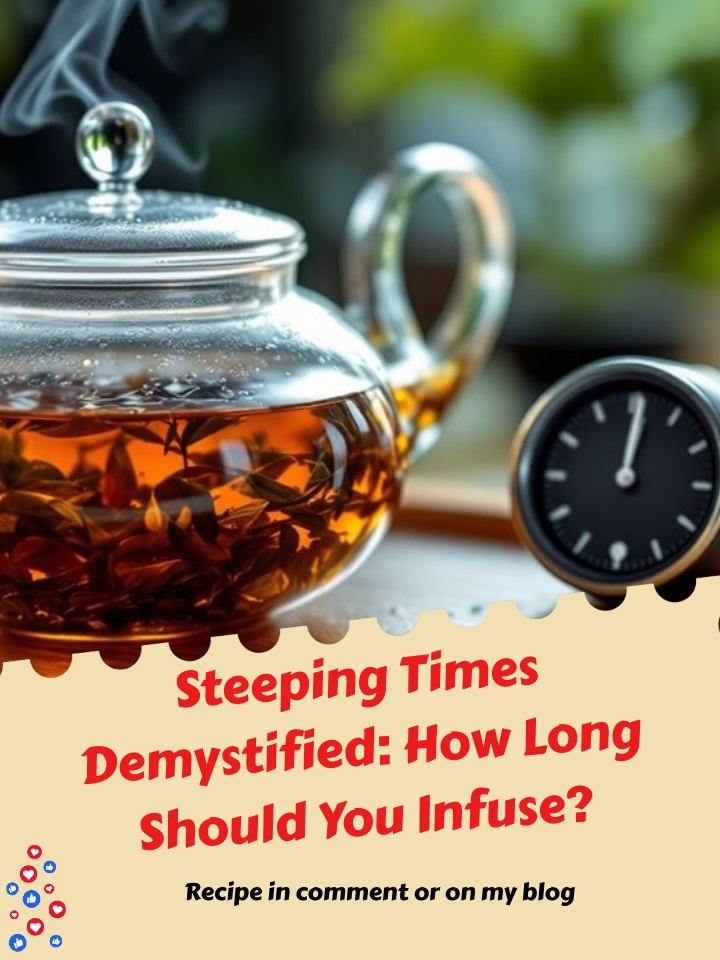
When you're brewing your favorite tea or coffee, the steeping time can make all the difference in flavor and aroma. You might think a longer infusion always means a richer taste, but that's not necessarily true. For instance, black tea typically needs just 3-5 minutes, while green tea often thrives with less time. What about those herbal blends that seem to take forever? Understanding the nuances of each type can elevate your experience greatly. Curious about how to perfect your steeping technique? Let's explore the specific guidelines that can transform your beverage enjoyment.
Key Takeaways
- Black Tea: Steep in boiling water for 3-5 minutes, tasting every 30 seconds after 3 minutes for preferred strength.
- Green Tea: Use 140°F-185°F water and steep for 2-3 minutes, adjusting time for lighter or stronger flavors.
- White Tea: Steep at 160°F-185°F for 30 seconds to 7 minutes, depending on the quality and personal taste preferences.
- Oolong Tea: Brew with water at 185°F-205°F for 3-5 minutes, experimenting with multiple infusions for varying flavor profiles.
- Pu-erh Tea: Steep near boiling for 3-5 minutes, enjoying the evolving flavors with each subsequent infusion.
Understanding Steeping Basics
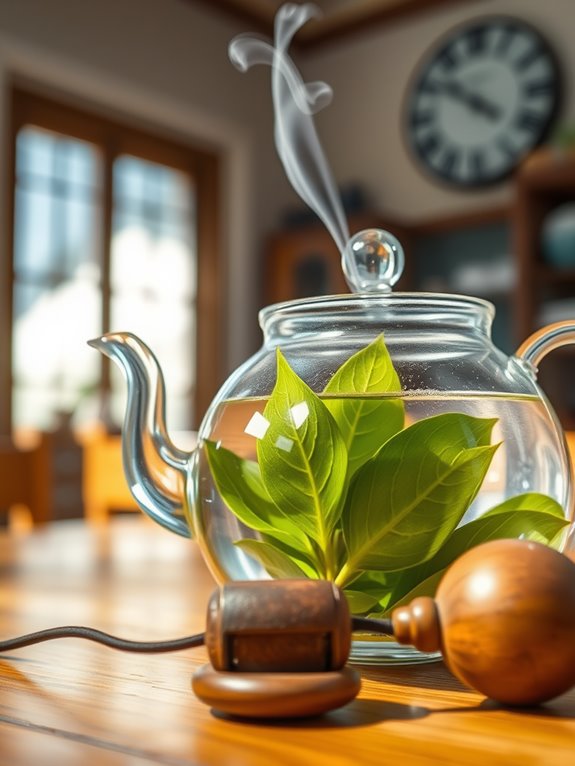
When you brew coffee, understanding the basics of steeping can make a significant difference in your final cup. The general guideline for most brewing methods is to steep for 3-4 minutes. This timeframe helps achieve ideal extraction, balancing flavors without tipping into bitterness or sourness. For methods like pour-over, aim for 3:30-4 minutes, while French press typically requires 4-5 minutes. Adjusting grind size is essential. Finer grounds extract faster, so you might need a shorter brew time. Conversely, coarser grounds need more time to extract fully. The right brewing time significantly impacts extraction quality, ensuring that you enjoy a sweet and smooth cup of coffee. If you notice bitterness, you might be overextracting, suggesting it's time to either reduce your brew time or switch to a coarser grind. On the other hand, if your coffee tastes sour or salty, it's likely underextracted, meaning you should increase the brew time or try a finer grind. Additionally, maintaining fast site performance can enhance your overall coffee brewing experience by ensuring you access the information you need without delays.
Black Tea Steeping Guidelines
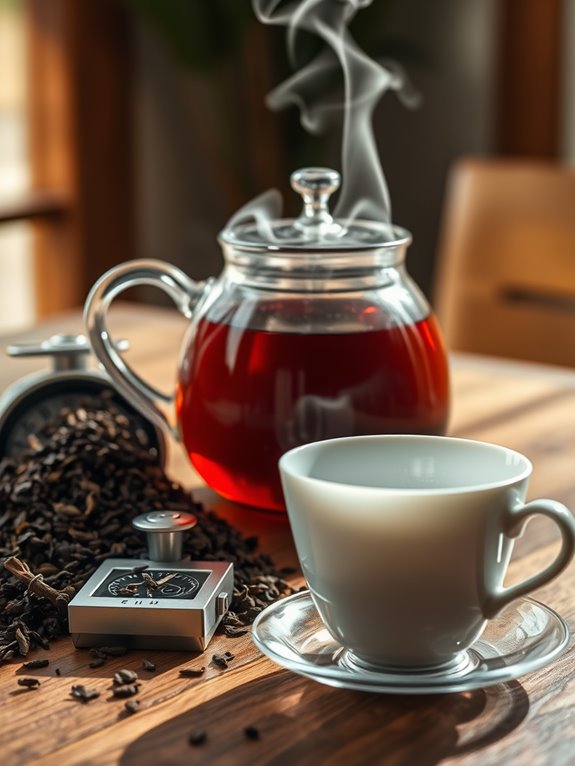
Steeping black tea requires specific guidelines to release its rich flavors and aromas. Start by using boiling water at around 100°C (195-212°F). While most black teas can handle boiling water without bitterness, some, like Darjeeling, benefit from slightly lower temperatures of 90-100°C. For general steeping time, aim for 3-5 minutes. However, if you're brewing Chinese black teas, a quicker 1-2 minutes will do, and you can often re-infuse them for multiple tastings. Use about 1 teaspoon of leaves per 6 to 8 oz of water, rinsing the leaves before steeping for a purer taste.
When you steep, consider using a gaiwan or a clay yixing pot. After the initial 3 minutes, taste every 30 seconds to find your preferred flavor strength. Balancing time, temperature, and technique is crucial for achieving the best results. Additionally, it's important to note that the best flavor is achieved with freshly boiled water, as it helps fully extract the tea's antioxidants and essential oils.
Green Tea Infusion Techniques
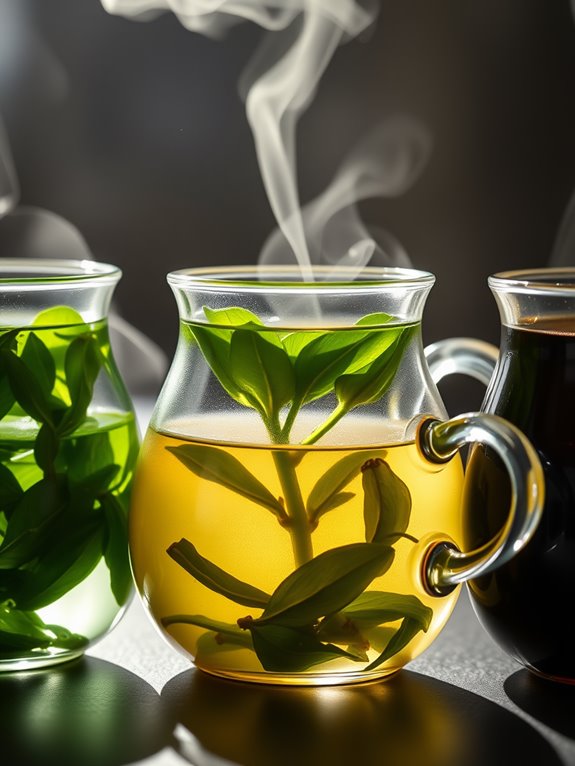
Green tea infusion techniques play an important role in releasing the delicate flavors and aromas of this beverage. To get started, prepare the right amount of tealeaves, avoiding moisture and heat that can degrade the rest. Pre-warming your pot with hot water enhances texture and taste. When adding tealeaves, pile them in the center for best infusion.
Temperature control is vital. Use a thermometer to verify your water's between 140°F and 185°F. For Japanese green teas like Gyokuro and Sencha, steep at lower temperatures for the finest results. Remember, the infusion time should balance with water temperature; lower temps allow for longer steeping. Water temperature significantly impacts the extraction of flavors and aromas. Additionally, consider using cold infusion methods for a refreshing twist on traditional brewing.
Explore different infusion techniques. Blanching involves gently adding water to the leaves, then draining. The top drop technique fills the pot with higher temperature water, allowing it to cool before adding tealeaves.
You can also try cold brewing by soaking tealeaves in room temperature water for about five minutes. If you're up for something unique, consider sun tea—steeping your leaves in sunlight for 3-4 hours.
These methods will elevate your green tea experience!
White Tea Brewing Tips
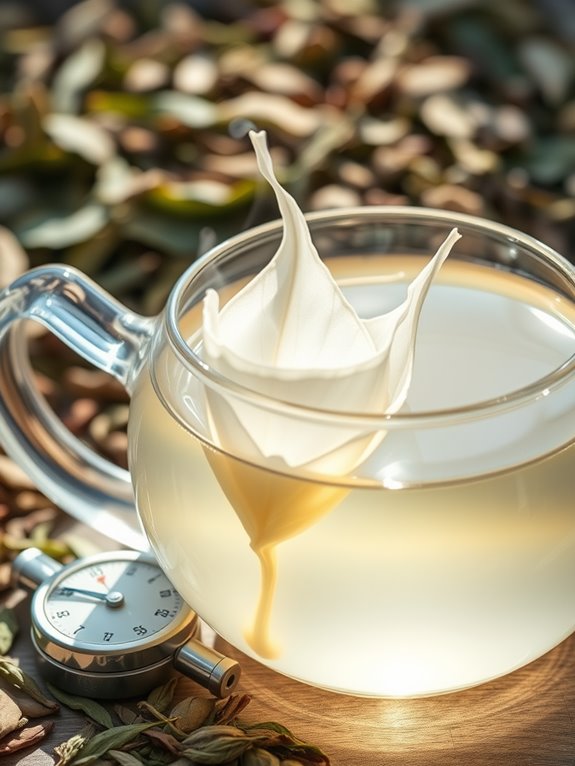
For the perfect cup of white tea, understanding the nuances of brewing is essential. Start by heating your water to a temperature between 160°F and 185°F. Avoid boiling water, as it can ruin the delicate flavors. Experts often recommend aiming for around 180°F to 185°F, especially for premium white teas like Silver Needle. Additionally, temperature affects the overall taste profile, influencing how the flavors are extracted during brewing. When it comes to the amount of tea leaves, use about 2 teaspoons for each 8-ounce cup. White tea leaves are less dense, so don't hesitate to be generous. If you're using whole leaves instead of bagged tea, you'll enjoy a better quality brew.
Steeping times can vary widely, ranging from 30 seconds to 7 minutes, depending on your taste. For the first steeping, 5 to 8 minutes is ideal, while subsequent steepings can be shorter, around 2 to 3 minutes.
If you're feeling adventurous, try gongfu brewing for a concentrated experience, steeping at 185°F for 20-45 seconds. Alternatively, cold brewing with lukewarm water for at least 5 hours can offer a unique flavor profile. Experiment to discover what you love best!
Oolong Tea Steeping Variations
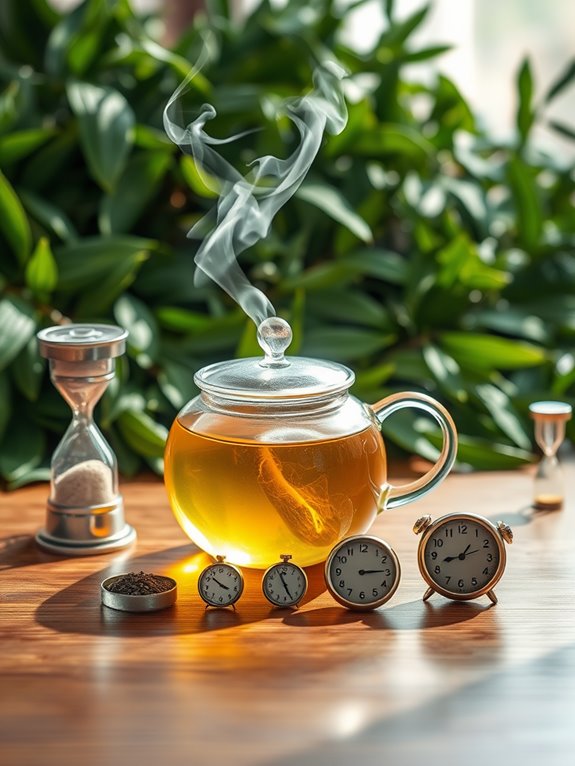
When exploring the world of oolong tea, you'll find that its diverse styles and flavors offer a unique brewing experience. To get started, you'll want to use water temperatures between 185-205°F (85-96°C) and prepare your leaves with a quick rinse.
For best flavor, aim to use 2-3 tablespoons of tea leaves, filling about one-third of your pot, and choose a gaiwan or Yixing clay teapot for steeping.
Steeping times can vary considerably depending on the oolong type. If you're using the Western style, steep for 3-5 minutes. For a more intricate Gongfu style, begin with 30-45 seconds, adjusting the time as you go.
Lightly oxidized oolongs benefit from shorter steeping times at lower temperatures, while darker varieties require longer steeping times at higher temperatures. This variation in steeping can greatly enhance your understanding of oolong tea characteristics during the brewing process. Additionally, remember that the leaves should uncurl fully to ensure maximum flavor extraction with each infusion.
Don't forget that oolongs are great for multiple infusions! You can expect different flavor profiles to unfold with each brew.
Exploring Herbal and Pu-erh Teas
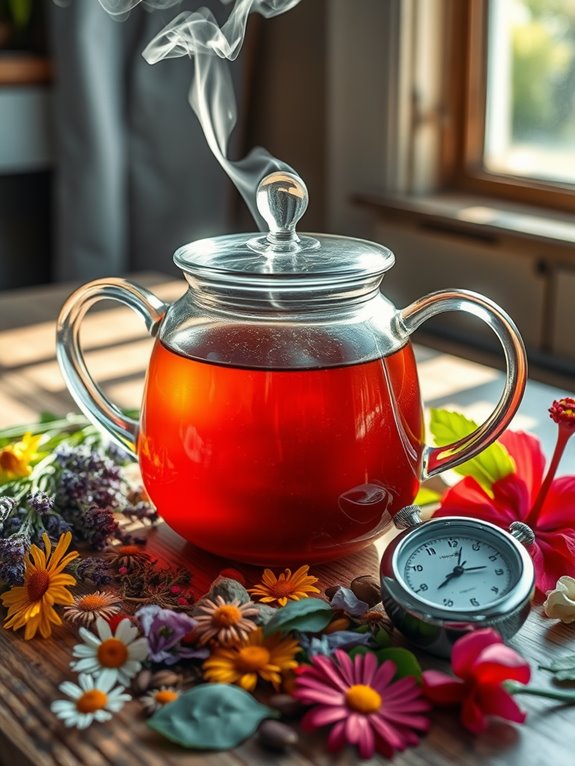
Herbal and pu-erh teas offer a fascinating investigation into the world of infusions, each with its unique steeping techniques and flavor profiles.
When steeping herbal teas, aim for a temperature between 200-212°F and let them steep for about 5-7 minutes. Crushing the herbs helps release essential oils, and covering the tea while steeping retains more benefits. Some blends may need up to 10 minutes or even overnight for ideal flavor.
For pu-erh teas, use boiling water at 195-212°F, with steep times typically ranging from 3-5 minutes. Raw pu-erh benefits from shorter steeping to reduce bitterness, while half and full baked varieties can steep longer for richer flavors. You can re-steep pu-erh multiple times, experiencing different flavor profiles with each infusion.
When steeping either type, use 1 tablespoon of herbs or pu-erh leaves per 8-10 ounces of water. Experiment with different steeping methods like a French press or a strainer to find what suits your taste best.
Whether for their medicinal benefits or unique flavors, mastering these steeping techniques enhances your enjoyment of herbal and pu-erh teas.
Frequently Asked Questions
Can I Reuse Tea Leaves for Multiple Steepings?
Yes, you can definitely reuse tea leaves for multiple steepings! Just steep them for 2-4 minutes each time and enjoy their flavors while they're fresh. Remember to store them properly between uses for the best results.
How Does Water Quality Affect Steeping Results?
Water quality greatly impacts your steeping results. If you use mineral-rich water, you'll enhance flavor complexity. Conversely, soft water may leave your tea dull. Experiment with different sources to find what works best for your brew.
What Equipment Is Best for Steeping Tea?
For steeping tea, you'll want a reliable kettle for precise heating, a tea infuser for loose leaves, and a good teapot to brew without adding unwanted flavors. Quality tools elevate your tea experience considerably.
Are There Health Benefits to Different Steeping Times?
Yes, different steeping times offer various health benefits. Shorter times preserve antioxidants and reduce bitterness, while longer infusions enhance flavor and nutrient extraction, including catechins and flavonoids, which support overall health. Choose based on your preferences.
Can Steeping Time Influence Caffeine Levels in Tea?
Yes, steeping time definitely influences caffeine levels in tea. By steeping longer, you extract more caffeine, with the first steep yielding the highest content. Adjusting your steeping time lets you control your caffeine intake effectively.
Conclusion
Now that you've got the scoop on steeping times for various teas, it's time to put this knowledge into action. Whether you prefer the boldness of black tea or the delicate notes of green, experimenting with these guidelines will help you find your ideal brew. Remember, the perfect infusion is all about personal taste, so don't hesitate to adjust steeping times to suit your palate. Enjoy the journey of flavor discovery with each cup you make!
Join Our Flavorful Journey!
Subscribe to our newsletter for exclusive updates, intriguing stories, and delicious new recipes crafted by our talented team.
Don't miss out! Sign up now and be the first to explore our latest creations and tips inspired by Keven's grandmother's wisdom.
Subscribe Today!





